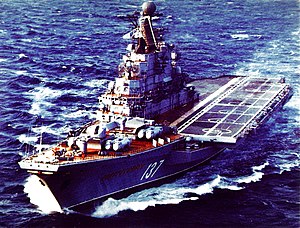Kiev-class aircraft carrier
This article includes a list of general references, but it lacks sufficient corresponding inline citations. (January 2013) |
 Novorossiysk in 1986
| |
| Class overview | |
|---|---|
| Builders | Chernomorsky Shipyard 444 |
| Operators | |
| Preceded by | Template:Sclass- |
| Succeeded by |
|
| Subclasses | Baku class |
| In service |
|
| Completed | 4 |
| Active | 1 |
| Preserved | 2 |
| General characteristics | |
| Type | Aviation cruiser |
| Displacement | 42,000–45,000 metric tons full load |
| Length | 273 m (896 ft) |
| Beam | |
| Draught | 10 m (33 ft) |
| Propulsion | 8 turbopressurized boilers, 4 steam turbines (200,000 shp (150,000 kW)), four shafts |
| Speed | 32 knots (59 km/h; 37 mph) |
| Complement | 1,200 to 1,600 |
| Armament |
|
| Aircraft carried |
|
| Aviation facilities | Abbreviated angled aft flight deck |
The Kiev-class aircraft carriers (also known as Project 1143 or as the Krechyet (Gyrfalcon) class) were the first class of fixed-wing aircraft carriers built in the Soviet Union.[1]
First laid down in 1970, the Kiev class was partially based on a design for a full-deck carrier proposed in Project Orel. Originally the Soviet Navy wanted a supercarrier similar to the American Template:Sclass-. However, the smaller Kiev-class design was chosen because it was considered to be more cost effective.
Unlike American or British carriers, the Kiev class is a combination of a cruiser and a carrier. In the Soviet Navy, this class of ships was specifically designated as a "heavy aviation cruiser" (Russian: Тяжелые авианесущие крейсера) rather than an aircraft carrier. This designation allowed the ships to transit the Turkish Straits, while the Montreux Convention prohibited aircraft carriers heavier than 15,000 tons from passing through the Straits.
The ships were designed with a large island superstructure to starboard, with an angled flight deck 2/3rds of the length of the total deck, and the foredeck was taken up with heavy surface-to-air and surface-to-surface missile armament. The intended mission of the Kiev class was support for strategic missile submarines, other surface ships and naval aviation; it was capable of engaging in anti-aircraft, anti-submarine, and surface warfare.
A total of four Kiev-class carriers were built and commissioned, serving in the Soviet and then Russian Navy. The first two ships were sold to China as museums, and the third ship was scrapped. The fourth ship, Admiral Gorshkov, was sold to the Indian Navy in 2004, and after years of extensive modifications and refurbishment, is currently in active service as INS Vikramaditya.[2]
General characteristics
- Designer: Nevskoye Planning and Design Bureau
- Builder: Nikolayev South (formerly Chernomorsky Shipyard 444)
- Power Plant: 8 turbopressurized boilers, 4 steam turbines (200,000 shp), four shafts
- Length: 273 metres (896 ft) overall (283 metres (928 ft) for Baku subgroup)
- Flight Deck Width: 53 metres (174 ft)
- Beam: 32.6 metres (107 ft)
- Displacement: 43,000–45,500 metric tons full load
- Speed: 32 knots (59 km/h; 37 mph)
- Aircraft: 26–30
- Crew: 1,200–1,600 (including air wing)
- Armament:
- Kiev and Minsk:
- 4 × twin P-500 Bazalt SSM launchers (8 missiles)
- 2 × twin M-11 Shtorm SAM launchers (72 missiles)
- 2 × twin 9K33 Osa launchers (40 missiles)
- 2 × AK-726 twin 76.2 mm AA guns
- 8 × AK-630 30 mm CIWS
- 10 × 21" torpedo tubes
- 1 × twin SUW-N-1 FRAS Anti-Submarine Rocket launcher
- Novorossiysk:
- 4 × twin P-500 Bazalt SSM launchers (8 missiles)
- 2 × twin M-11 Shtorm SAM launchers (72 missiles)
- 2 × AK-726 twin 76.2 mm AA guns
- 8 × AK-630 30 mm CIWS
- 1 × twin SUW-N-1 FRAS Anti-Submarine Rocket launcher
- Baku:
- 6 × twin P-500 Bazalt SSM launchers (12 missiles)
- 24 × 8-cell 9K330 Tor vertical SAM launchers (192 missiles)
- 2 × 100 mm guns
- 8 × AK-630 30 mm CIWS
- 10 × 21" torpedo tubes
- 2 × RBU-6000 anti-submarine rocket launchers
- Kiev and Minsk:
- Date Deployed: 1975 (Kiev)
Ships
| Name | Project No. | Namesake | Builder | Laid down | Launched | Commissioned | Fate |
|---|---|---|---|---|---|---|---|
| Kiev subgroup | |||||||
| Kiev | 1143 | City of Kiev | Soviet Shipyard No. 444, Mykolaiv | 21 July 1970 | 26 December 1972 | 28 December 1975 | Sold to China as a museum, 1996 |
| Minsk | 1143 | City of Minsk | 28 December 1972 | 30 September 1975 | 27 September 1978 | Sold to China as a museum, 1995 | |
| Novorossiysk | 11433/1143M | City of Novorossiysk | 30 September 1975 | 26 December 1978 | 14 September 1982 | Broken up at Pohang, 1997 | |
| Baku subgroup | |||||||
| Admiral Gorshkov (ex-Baku) |
11434 | Sergey Georgiyevich Gorshkov | Soviet Shipyard No. 444, Mykolaiv | 17 February 1978 | 1 April 1982 | 11 December 1987 | Sold to India in 2004, now INS Vikramaditya |
See also
- Flight deck cruiser
- List of ships of the Soviet Navy
- List of aircraft carriers of Russia and the Soviet Union
- List of ships of Russia by project number
References
External links
- Article on the Kiev Class Template:Ru icon
- Article in English from FAS
- History of the Kiev Template:Ru icon
- Project 1143 Kiev Template:Ru icon
- Kiev Class Aircraft Carriers
- MaritimeQuest Kiev Class Overview
- History of soviet aircraft carrier development
- Project 1143 Kiev
- Project 11434 Baku/Admiral Gorshkov
